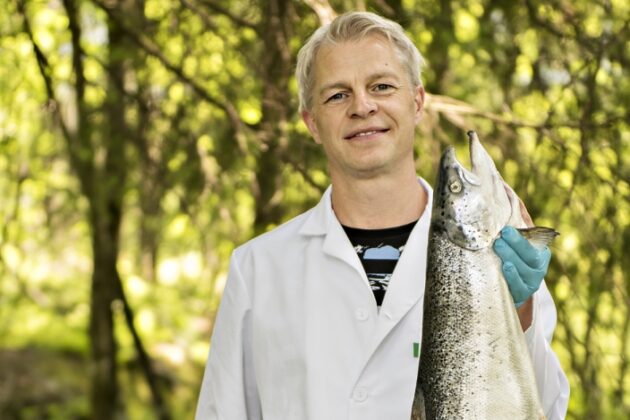How to check how fresh fish is

Do you want to buy a whole fish, but don’t know how to assess its quality? Here's a crash course in using your senses to determine how fresh the fish is.
A whole fish can tell us a great deal if we use our senses correctly. Its smell, texture and the state of its eyes, gills and skin tell us a lot.
“We don’t use our senses as much as we used to. I, for one, believe the food will be much more interesting if we take in the smell and examine the fish as a whole”, says Mats Carlehög, sensory scientist at Nofima.
Being a sensory scientist means that he describes products based on their taste, appearance, smell, texture and sound. Nofima’s professional sensory panel helps him in this work by providing objective descriptions of the various products.
Here’s what you should look for
Here, Mats will teach you the tricks of the trade that professional fish buyers use for quality assessment. These methods can be useful if you buy whole gutted fish or have a catch of your own that’s been stored for a few days.
He will use salmon as an example for assessing quality, but the principles for assessing other species are similar. First, he looks at the skin.
The skin
The skin should have a mother-of-pearl sheen and be free of marks. When the colour turns yellowish and the skin loses its sheen, the fish has already started to degrade.
“The smell of completely fresh salmon is neutral with a touch of seaweed. If you notice a slight smell of cucumber, metal or hay, it is not completely fresh. If it starts smelling slightly sour, you need to eat it as soon as possible”, says Mats.
Texture

If the fish is completely rigid, stiff as a stick if you hold it by the tail, it was caught or slaughtered only a short while ago. When fish and other animals die, they enter a state of rigor mortis after a few hours, which will last anywhere from a few hours to several days depending on how cold it is and the fish’s metabolism at the moment of death. The fish you find for sale at the fish monger is usually past the stage of rigor mortis, and then you can press down with a finger to see how much of a mark it leaves to determine where in the degradation process the fish muscle is.
“Marks that disappear fast means the fish is fresher than fish where it stays for a few seconds”, says Mats.
Eyes

“With fresh fish, the eyes should be clear, dark and with a metallic sheen. If they are turning grey, matte and sunken, the fish is already in an early stage of decomposing.”, says Mats.
Gills

If you could pick only one parameter for assessing the freshness of fish, choose the gills. The gills are the lungs of the fish and where fresh blood meets air. If the gills are still red, the fish was slaughtered only a short time ago. If their colour is turning brown, grey or green, the fish is no longer fresh.
The gills should also have a fresh smell as the skin, and the same goes for the abdomen.
What should you do with fish that is no longer fresh?
“You can safely eat fish that is no longer completely fresh. If you have fish often, you will get familiar with the signs of good and poor quality, as it’s a question of experience. It takes a lot for the fish to be unsafe to eat as long as you heat it properly”, says Mats.
And if you need help, there is an app for assessing the quality of fish called “How fresh is your fish?”.
The quality depends on storage
The decomposition process begins immediately after the fish is slaughtered. Chemical and enzymatic reactions and bacteria break down the fish, which appears as changes in shine, texture, colour and smell. The decomposition time depends on how the fish has been treated during slaughter and how it has been stored. That is why you cannot always rely on the last day of use date.
“Some people think the fish is good to eat only for a very short period of time, but that is actually not the case. Fresh fish can go bad after a few days if the storage temperature is too high, while fish which is two weeks old can be good to eat if it has been properly kept at low temperatures, preferably on ice”, says Mats.
“In other words – use your senses the next time you buy fish!”
Changing habits
Statistics from the Norwegian Seafood Council show that Norwegians bought 53 %less whole fresh salmon in 2012 than in 2009, while they bought 57 -% more fresh salmon fillet, mainly packaged and labelled.
It’s a safe choice, but it is natural to assume we are losing some knowledge along the way. When, for example, was the last time you filleted a whole fish?
About the freshness app
- The “How fresh is your fish” app can be downloaded for Apple and Android devices, and is available in 11 languages.
- Contains 14 species of fish & shellfish
- In just a few steps, you can see if the fish product has any flaws, if it has the right level of freshness and the remaining shelf life of the fish.
- The standardised method behind the app is called QIM – the Quality Index Method.
- In brief, the QIM method is about finding out the shelf life of a fish from the time it is assessed. In other words, one doesn’t need to know the time of slaughter to determine the shelf life. Demerit points from 0 to 3 are awarded based on appearance, smell, gills, eyes and the texture of the entire fish. The method has been developed by Nofima’s scientists in cooperation with scientists from a number of European countries.
- The final result is presented immediately.
- The app is intended for professional users such as fish producers, distributors, buyers and stores that need to assess the shelf life of the fish. However, it can also be used by ordinary consumers on the condition that the fish is raw, fresh, gutted and whole.
- The app is funded by Nofima and has been developed in a partnership with Imares Wageningen UR in the Netherlands.
Facts about sensory science
- Sensory science is a scientific discipline used to evoke, measure, analyze, and interpret reactions to those characteristics of food and other materials as they are perceived by the senses of sight, smell, touch, taste, and hearing
- In sensory analysis, sensory asessors describe the products’ appearance, smell, taste, texture and sound.
- Nofima’s sensory panel at Ås – which has been in operation for more than 40 years– has 10 professional sensory assessors.
- A trained panel should not be concerned about whether or not they like the products they are served, but should only give an objective assessment of the products. The research question determines which analysis method is used.
Contact person
Topics
Seafood

